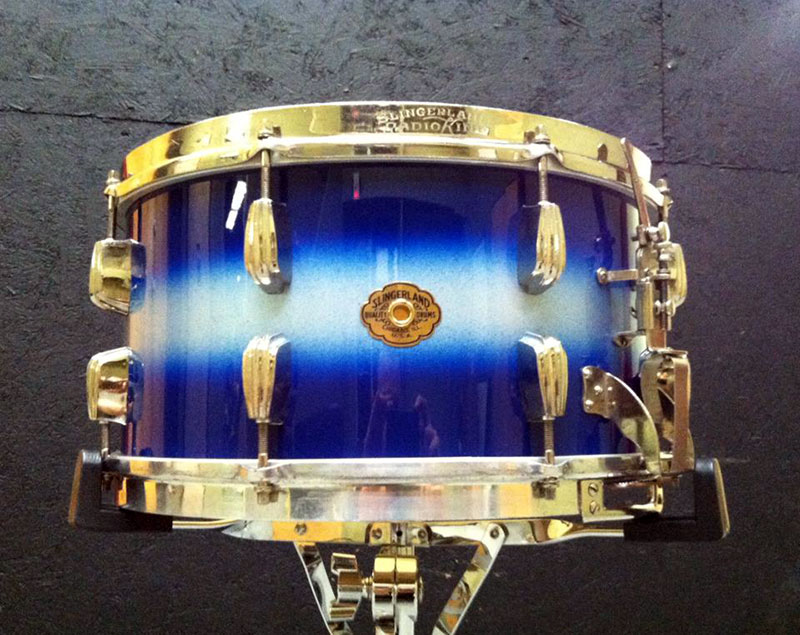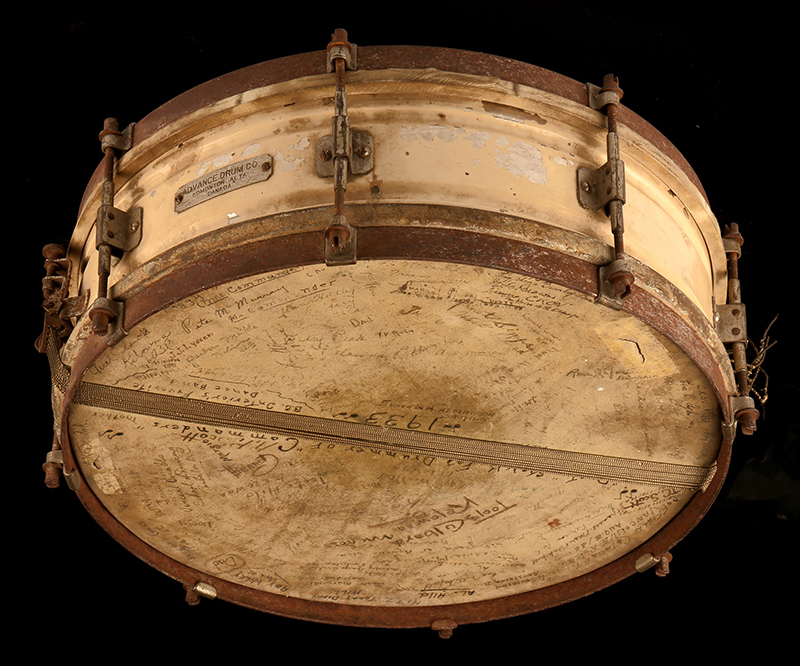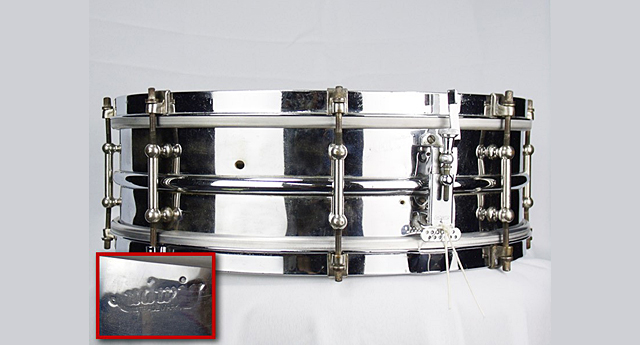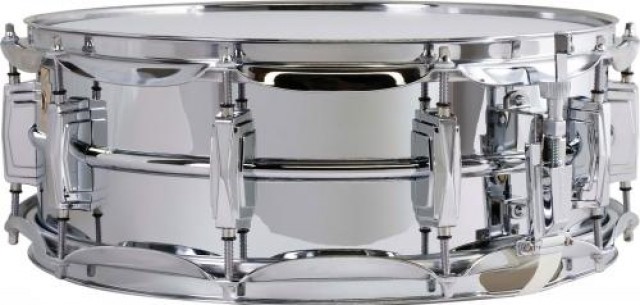I went in to the lovely home of the owner of this set. He is in his 80s, and after a few minutes of greeting I was taken to the set. It wasn't set up, but I was encouraged to set them up and play on them or whatever I wanted to do. I just enjoyed looking at everything. There was also a wonderful cymbal set included, some of them were "K" Zildjians. There were stands, other hardware, and a box full of great old percussion "stuff." After I had looked it all over, I sat down with the man and enjoyed a long talk with him. He has a life filled with great experiences and I'm glad I got to hear some of them. If I had left without the drums and only got to talk to this guy, I would still be richer from the experience.
Read more1939-41 Leedy Broadway Standard "T-Bird" Engraved Snare
This was an easy one but I do have a restoration tip to pass along. This is purely personal but maybe a few restorers out there will find this useful. If you notice on all of my restorations you will see “aged” snare cord. I think that it looks out of place to have brand new white snare cord on an 85 year old drum; functionally it’s no problem, visually it drives me nuts. Here are two tips for you... 1. I use Yamaha snare cord model SNC-10 but before installing the snares I run the cords through a used (blackened) piece of Cape Cod Polishing Cloth, this darkens (antiques) the white cord and in my opinion makes it more realistic looking... 2. I just discovered Puresound makes model MS4 (dark brown brained line). This is what I used on the drum in this article.
Read moreJuly 2014 - Red Headed Step Children
But what about all the vintage and rare drums that have been modified with extra holes, unoriginal parts etc.? What about those red headed bastard stepchildren?
It is my theory that they will become more and more desirable as the herd is thinned over the coming decades. What made me realize this was one particular seller at the Chicago Drum Show who asked me if there were going to be a lot of “hipsters” at my Nashville Drum Show. He said that in Austin, where there are hundreds and hundreds of working drummers in that busy music scene, they are buying “player" vintage kits and snares, not the collector level drums. They are buying them for the sound, not the collectability. It made me realize just how much the vintage drum world has grown and how the less than perfect old drums need to be preserved too.
Read more1940s Restored Radio Kings
We found Joe Ciucci on Facebook a few months ago sharing pictures of his grandfather's one-owner 1940s Slingerland Radio Kings. These drums were masterfully restored by ATL Drum Collective in Atlanta, GA. We're going to run a feature article and interview with Joe in the coming months, stay tuned for more information and history, pictures of the full kit, and audio/video too!
Zickos Clear Cast Acrylic Drums
The first company to ever produce clear cast acrylic drums, Zickos nearly had Keith Moon as an endorser. Apparently, he did not like the sound of the drums. He was known to have played them on just a handful of gigs.
http://www.thewho.net/whotabs/gear/drums/drumszickos.html

Noble & Cooley 1986 SS Classic
Single ply maple shell and maple reinforcing rings, honey maple finish, all brass N&C proprietary hardware. One of the first modern Noble & Cooleys. Notice the hex lug in the middle. This was moved to the lower "acoustical node" position soon after this model. I believe that this model with the hex lug in the middle is superior in tone since the middle of the shell is the node of the fundamental pitch just as the center of a drum head is the most prominent node. From the George Lawrence collection.
Pre-WWII Slingerland Mystery Drum
Can you identify this drum? If you've got some info, leave us a comment below.
1950s Slingerland One-Ply Steam Bent Radio King
This month we're featuring a 1950s Slingerland one-ply steam bent Radio King, 6.5 x 14 with clamshell strainer and stick chopper hoops. Courtesy of the Mell Csiscila collection.
Ronn Dunnett's Early 1900s Advance Drum Company Snare
A very special treat for everyone today... I know of only 4 examples of this particular snare drum and I have only actually SEEN one - mine - before this one landed on my bench. The other two are reported to be in the hands of Joe Montinerri and Johnny Craviotto (however Johnny says his may have been lost or stolen). This is an Advance Drum Company snare drum. The Advance Drum Company is the first Canadian drum company ever and was started by George Way in Edmonton, Alberta in the early 1900s.
George Way was responsible for a substantial number of inventions that remain in use on modern drums. Way invented the swivel / self-aligning lug and the first parallel action throw off. He was the first to ever wrap a drum in a pearl finish. He also introduced the China cymbal (what he called the "Chinese Sneeze" cymbal.
I'm not sure if this drum was painted at the Advance factory or if it was painted afterward. Either way, as you can tell by the head it has been around for a very long time - through 2 world wars and a lot more.
The owner brought this to me and asked me to make it playable. I agreed to do this, but with the understanding that I would not remove any of the patina. It is an amazing piece of drum history and while I look forward to hearing it I will do my utmost to maintain the integrity of the drum as you see it here.
-Ronn Dunnett www.dunnett.com
1923 Ludwig 5x15 Theatre Concert Brass snare drum
Drum Stats
Ludwig 1923 Ludwig Original All Metal Separate Tension Drum - No. 4 - 5" x 15"
Theatre Concert model
Two piece brass shell with soldered second flange bearing edge
Original throw off replaced
8-lug 15" model
Not shown in any of the Ludwig catalogs
From the George Lawrence collection
Ludwig LM400 Supraphonic
Model: Ludwig LM400 Supraphonic 5x14 snare drumYear: 1963 to present
Description: Current model is U.S. made and has a spun aluminum seamless shell with chrome plating, imperial lugs, and a P85 throw off.
Prices as of 12/01/2013: Current Retail Price: NEW $695 (MAP $459) Excellent Condition Used (High Price): $300 Good Condition Used (Median Price): $200 Fair Condition Used (Low Price): $100
Opinions and debate about these average values are welcome in the comments section below, and values will change according to review of evidence present. Also welcome are comments about identifying features and timeline.
History and Identification :
The Ludwig Supra Phonic snare drum is one of the most popular snare drums of all time. It was used extensively on records by rock and jazz drummers of the fifties, sixties and seventies. Who knows how many hundreds of thousands of them were made over six decades? The SupraPhonic was introduced as the Super Ludwig in 1958 and was available in 5" depth only. The "Supra", as it was nicknamed, went through many major and minor changes over the years. The early chrome over brass shells and brass hoops are more desirable and rarer than the later chrome over aluminum shell drums and steel hoops. The chromed brass and chromed aluminum shells are hard to distinguish between and lots of fuss is made by collectors over how to tell the difference. The timeline of the changes below will help you date your drum. The only true 100% guaranteed way to tell if it's a brass shell underneath the chrome is to take one of the lugs or the strainer off the drum and remove a tiny bit of the chrome from the lug hole with a small file. If the brass shows through - bingo! If it's a darker grey color it's aluminum. Also if the chrome is flaking off the drum, it's an aluminum shell. Aluminum does not like to be chromed. Why are the brass ones so desirable? -The rarity and the superior tone.
The 1958 - 1963 chrome over brass and clear lacquer over brass shell Super Ludwigs range in price from $600 to $1000. Most aluminum and steel models correspond to the pricing above. A new or used Supraphonic of any stripe is a drum worth owning.
Super Ludwig and Supraphonic Timeline
1958: WFL badge (very rare), WFL P83 throw off, narrow crimped snare beds, brass shell has two folds- one flange downward from the bearing edge and a second fold back toward the shell, different from the aluminum shell which does not have the second fold. These drums are the best sounding of all the Supras because of the extra flange in the edge.
1958 - 1959: Ludwig Keystone brass and blue "transition" badge
1958 - 1960: Two piece brass shell w vertical weld seam, crimped narrow snare beds
1960 - 1963: Brass keystone badge w no serial number & etched characters. 6.5" depth model LM402 added, imperial lugs redesigned to be more hollow thus lighter
1961: Lacquered brass shell discontinued, a few shells were made out of steel, the one piece spun aluminum shell with one flange is introduced. The aluminum shells are lighter in weight and higher in pitch than the brass shells. Super Sensitive Supraphonic is introduced, snare beds widened to 8", round knob muffler replaced by the P-4067 "baseball bat" muffler w red felt. The felt was changed to white in 1964
1963: Name changed from Super Ludwig 400 to Supra-Phonic 400, serial numbers began to be stamped on badges in late 1963 - 4 digits - in '64 five digits - and in '65 six digits, Lug screws changed from hex head screws and washers to flat head screws w small bell washers.
1964: Brass hoops were changed to steel, felt on baseball bat muffler changed to white felt
1968: Baseball bat muffler replaced by 1" knob muffler, P83 strainer replaced with P85, shell material changed to a different non ferrous aluminum alloy; these shells are stamped AG on the inside
1969: First Blue and Olive parallelogram badges w no serial numbers, a few Supras were made without badges during this transition
1970: Lud-a-loy stickers added to inside of shell, a few Supraphonic 400 snares are made with brass shells and can be identified by the letters B or BR stamped by the muffler, and by modified shorter blue and olive badges.
1977: Strainer and butt height changed from 1/2" to 7/8"
1980: P85 12 strainer holes for gut snares changed to just two holes for wire snare strings
1984: P85 two hole model replaced by one slot P85 model
1988: Monroe badge replaces old Keystone badge
1994: New options offered on a Supraphonic 400: tube lugs, hammered shells, brass shells and bronze shells
There are exceptions to all of these variations and changes. Ludwig experimented a lot with different components, especially during the early sixties. One can find drums with the wrong shell, badges, lugs, and other parts that were factory originals due to shortages, old stock, custom builds for artists, etc., so these identifying factors are not written in stone, but it is a fairly reliable guide.
I am not the world’s foremost authority on vintage drums but I know enough to get me in trouble and I know there are guys and gals who know more than I do! Please, if you have differing information and opinions, I would love to hear from you in the comments below, but please be civil about it.
Thanks, George Lawrence - who wishes now that he hadn't sold his 1963 COB Supra.
Telestar Mid 60's Snare Drum
Drum Stats
Made in Japan
Luan plywood shell with maple reinforcing rings
Recovered in peacock satin flame wrap by Sam Bacco -three point reproduction strainer
Original Slingerland type hoops, Gretsch type lugs
Ultra cool Telestar badge
"Thar She Blows" - John Aldridge, Founder's Blog
If you're new to NSMD, you may not know that it started out as a newsletter between a group of drum collectors for the purpose of sharing info, selling and buying, and general communication about vintage drums. Prior to Not So Modern Drummer's appearance there was very little printed information available on the topic of vintage drums.
Andy Florio, a respected drummer, actor, and historian, had formed an association of "Drumologists" and sent out a newsletter or two himself, but I didn't discover this until I'd already started publishing Not So Modern Drummer. Andy was a wealth of knowledge, having been a collector of vintage gear since the 1960's or earlier. I still have my membership card to the National Association of Drumologists, along with many fond memories of talking to Andy on the phone, deciphering the history of drums!
Read more










